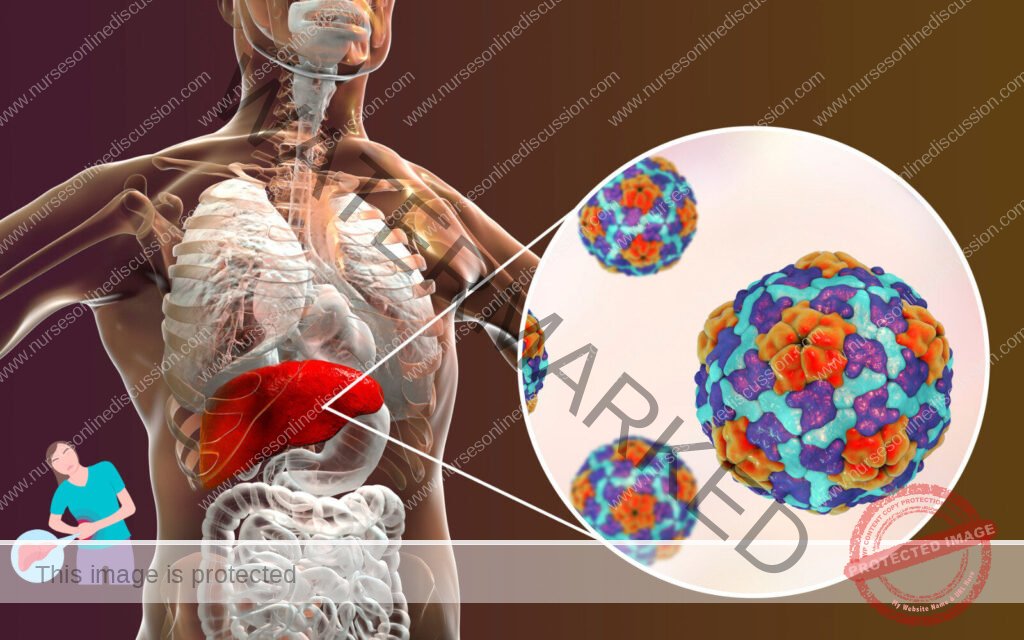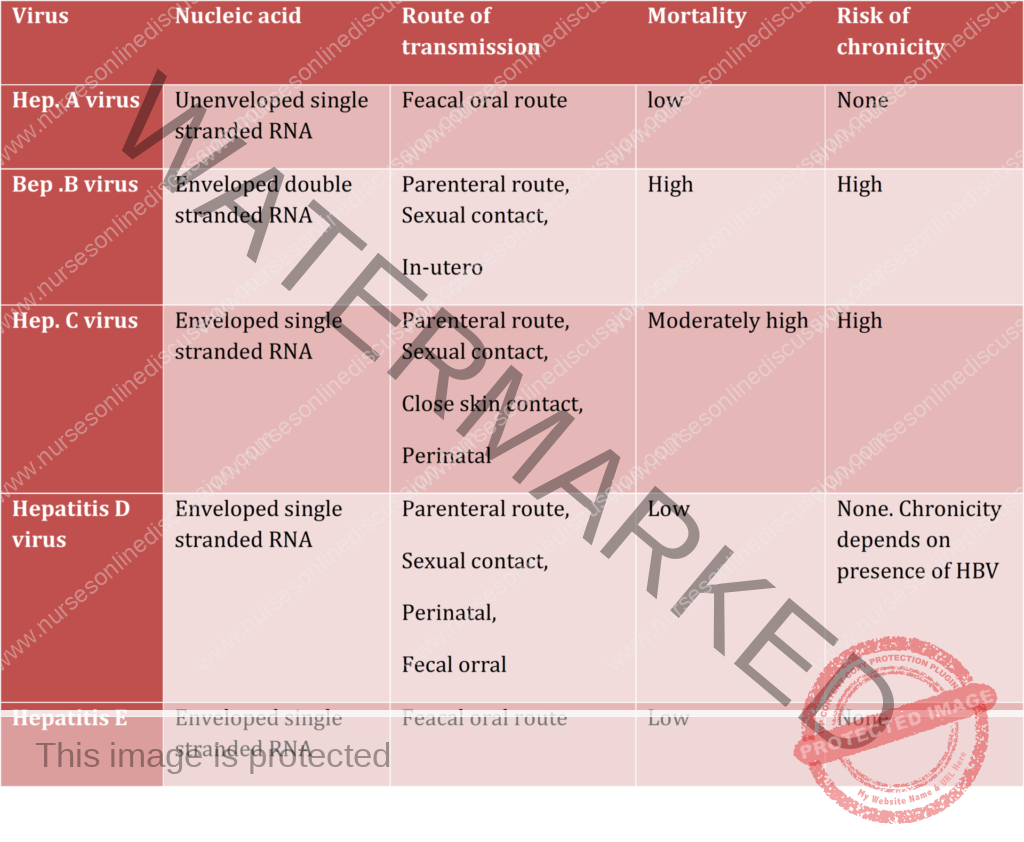Medical Nursing (II)
Subtopic:
Hepatitis

Hepatitis
- Hepatitis is a condition characterized by inflammation of the liver and is caused by viruses i.e. hepatitis A,B, C,D,E.
- Chronic hepatitis is mainly caused by hepatitis B,C and D.
- Patients may be symptomatic or asymptomatic.

Hepatitis A
Hepatitis A (formerly known as infectioushepatitis) is an acuteinfectious disease of the liver caused by the hepatitis A virus (HAV).
Transmission
- It is usually spread by eating or drinking food or water contaminated with infected feces.
- It may also be spread through close contact with an infectious person.
Signs and symptoms
- Symptoms typically appear 2 to 6 weeks (the incubation period) after the initial infection.
- 90% of children do not have symptoms.
Symptoms usually last less than 2 months, although some people can be ill for as long as 6 months.
- Fatigue
- Fever
- Abdominal discomfort
- Nausea
- Loss of appetite
- Joint pains
- Urticaria
- Jaundice, a yellowing of the skin or whites of the eyes due to hyperbilirubinemia
- Diarrhea
- Clay-coloured feces
Diagnosis
- Serum IgG, IgM
- Alanine transferas enzyme(ALT)- liver enzyme. It is present in blood at higher levels than normal.
- Blood for HAV: Hepatitis A virus is present in the blood (viremia) and feces of infected people up to two weeks before clinical illness develops.
Treatment
- There is no specific treatment for hepatitis A.
- Sufferers are advised to rest, avoid fatty foods and alcohol (these may be poorly tolerated)
- Eat a well-balanced diet, and stay hydrated.
Hepatitis B
- Hepatitis B is an infectious hepatitis caused by the hepatitis B virus (HBV).
Transmission
The hepatitis B virus is known as a blood-borne virus because it is transmitted from one person to another via blood or fluids contaminated with blood.
- Direct contract with blood may occur through the use of dirty needles during illicit drug use, accidental needle sticks experienced by healthcare workers, or contact with blood through other means.
- Semen, which contain small amounts of blood, and saliva that is contaminated with blood also carry the virus.
- The virus may be transmitted when these fluids come in contact with broken skin or a mucous membrane (in the mouth, genital organs, or rectum) of an uninfected person.
- Another important route of transmission is from an infected mother to a newborn child, which occurs during or shortly after birth.
People who are at an increased risk of being infected
- Men or women who have multiple sex partners, especially if they don’t use a condom
- Men who have sex with men
- Men or women who have sex with a person infected with hepatitis B virus
- People with other sexually transmitted diseases
- People who inject drugs with shared needles
- People who receive transfusions of blood or blood products
- People who undergo dialysis for kidney disease
- Institutionalized mentally handicapped people and their attendants, caregivers, and family members
- Health care workers who are stuck with needles or other sharp instruments contaminated with infected blood
- Infants born to infected mothers
Signs and Symptoms
- Loss of appetite
- Feeling tired (fatigue)
- Nausea and vomiting
- Itching all over the body
- Pain over the location of the liver (on the right side of the abdomen, under the lower rib cage)
- Jaundice (a condition in which the skin and the whites of the eyes turn yellow in color)
- Dark urine (the color of cola or tea)
- Pale-colored stools (grayish or clay colored)
Symptoms of liver damage may include the following:
- Fluid retention causing swelling of the belly (ascites) and sometimes the legs
- Weight gain due to ascites
- Persistent jaundice
- Loss of appetite, weight loss, wasting
- Vomiting with blood in the vomit
- Bleeding from the nose, mouth, or rectum; or blood in the stool
- Hepatic encephalopathy (excessive sleepiness, mental confusion, and in advanced stages, development of coma)
Diagnosis
- Hepatitis B antigen (anti-HBc).
- Viral DNA (viral load)
- Liver function tests
- Blood for electrolytes if patient has been vomiting a lot.
- CT scan or ultrasound: To detect the extent of liver damage and may also detect cancer of the liver caused by chronic hepatitis B.
- Liver biopsy: May be done to detect the extent of liver damage or to evaluate how well a treatment is working.
- Other tests may be ordered to rule out other medical conditions.
Treatment
Acute hepatitis B usually resolves on its own and does not require medical treatment.
Medical Treatment
- If the infected person is dehydrated from vomiting or diarrhea, IV fluids are prescribed to help patient feel better.
- Medications may also be used to control other symptoms.
- People with mild symptoms can be cared for at home.
- Pegylated interferon alfa. It slows the replication of the virus and boosts the body’s immune system to fight the infection.Treatment is given for 48 weeks by injection or orally.
- Nucleoside/nucleotide analogues (NAs) e.g. Adefovir , Entecavir, lamivudine, Heptovir, Heptodin, Telbivudine and tenofovir.
Hepatitis B Prevention
- Hepatitis b vaccine
- If you are sexually active, practice safe sex.
- Correct use of latex condoms can help prevent transmission of HBV, but even when used correctly, condoms are not 100% effective at preventing transmission.
- Men who have sex with men sh’d be vaccinated against both hepatitis A and hepatitis B.
- If you inject drugs, don’t share needles or other equipment.
- Don’t share anything (including grooming products) that might have blood on it, such as a razor, toothbrush, fingernail clippers, etc.
- Health care workers should follow standard precautions and handle needles and sharps safely.
Hepatitis C
It belongs to the class of viruses called Flavviruses.
Route of transmission
- Parenteral route
- Close body contact through body fluids.
- Intravenous drug abuse.
- Sexual contact
- Mother to child transmission
- Traditional administration of medicines/practices that involves cutting of skin.
Clinical features
- Mostly asymptomatic
- Symptoms are generally mild and vague.
- Decreased appetite
- Fatigue
- Nausea
- Muscle or joint pains
- Weight lossand rarely does acute liver failure
Chronic infection
- About 80% of those exposed to the virus develop a chronic infection. (This is defined as the presence of detectable viral replication for at least six months).
- Chronic infection after several years may cause cirrhosis or liver cancer.
Dignosis
- Hepatitis Cantibodyenzyme immunoassay or ELISA,
- HCV RNApolymerase chain reaction (PCR) (viral load).
- Biopsy, to determine the degree of liver damage
Treatment
- Combination of interferon alpha andribavirin for a period of 24 or 48 weeks.
- Sofosbuvir with ribavirin and interferon.
- Surgery-liver transplantion
Prevention
- No vaccine available at the moment.
- Control from infections
- Proper disposal of hospital waste
- Reducing parenteral injections.
Hepatitis D (HDV)
Hepatitis D, is a disease caused by a small circular enveloped RNA virus.
Transmission
- The routes of transmission of hepatitis D are similar to those for hepatitis B.
- Infection is largely restricted to persons at high risk of hepatitis B infection, particularly injecting drug users and persons receiving clotting factor concentrates.
Treatment and prevention
- The vaccine for hepatitis B protects against hepatitis D virus because of the latter’s dependence on the presence of hepatitis B virus for it to replicate.
- Interfron alpha can be used in reducing the severity of the infection.
Hepatitis E
Hepatitis E is a viral hepatitis caused by infection with a virus called hepatitis E virus (HEV).
Transmission
- It is spread mainly by the fecal-oral route due to fecal contamination of water supplies or food.
- Person-to-person transmission is uncommon.
Signs and symptoms
- The incubation period of hepatitis E varies from 3 to 8 weeks.
- Jaundice
- Fatigue
- Nausea.
- Anorexia
- Abdominal pain.
Diagnosis
- Viral RNA becomes detectable in stool and blood serum during incubation period.
- Serum IgM and IgG antibodies against HEV.
Prevention
- Improving sanitation is the most important measure in prevention of hepatitis E.
- Vaccination
Treatment
- There is no specific treatment for acute hepatis E infection.
- Ribavarin or a combination of ribavirin and peginterferon.
- Supportive treatment.
Get in Touch
(+256) 790 036 252
(+256) 748 324 644
Info@nursesonlinediscussion.com
Kampala ,Uganda
© 2025 Nurses online discussion. All Rights Reserved Design & Developed by Opensigma.co

